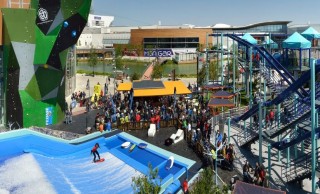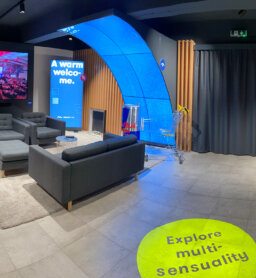Everything you need under one roof – that was the idea behind the original shopping centre format. But in the face of growing competition from the online sector, shopping centres no longer necessarily have all that much to do with actually going shopping. But that doesn’t mean the end for them, by any stretch of the imagination. A look at the shopping mall renaissance ahead.

Like a phoenix from the ashes: the shopping centre of the future

Glide along without a care in the world in a gondola before alighting at an impressive plaza, strolling around the shops and savouring a refreshing ice cream. What sounds like a trip to Venice is in fact a day out at the Puerto Venecia shopping centre in Spain. Here – and this is a development in the retail sector that we are all familiar with by now – the focus is no longer on shopping, but the overall experience. And that is exactly what shopping centres need to offer in this age of Amazon and all the other online retailers.
By 2030 around one third of all shopping will be done on the internet
Shopping centres are increasingly reinventing themselves as lifestyle hubs, places where the boundaries between shopping and entertainment are blurring beyond all recognition. All of a sudden, shopping is becoming a bit of an afterthought at shopping centres. After all, anyone looking to quickly snap up a product turns to the convenience of the internet. All from the comfort of their sofa, doing away with the need to carry it all home. And the online sector is set to continue growing over the next few years: according to Statista and eMarketer around ten percent of all transactions are currently conducted online.
From showrooming to virtual window shopping
Businesses that fail to keep step with the pace of digitalisation are already starting to fall victim to a phenomenon dubbed “showrooming”: customers go to bricks and mortar stores for sales advice or to see the physical product and head back online to order it for less. To avoid losing customers to online retailers, traditional stores are going to have to manage the balancing act between real and digital services.
Sporting goods manufacturer adidas has been playing with innovative strategies over the past few years. One of its strategies: giving customers access to interactive virtual display windows outside normal opening hours where they come into contact with a broad range of products that they can save to their phone using the URL provided or make a purchase online there and then. Digital window shopping has arrived. Another is adidas 360° Shopping, which takes you on a virtual trip around the brand’s newest store in Sweden. And shopping in its real life stores is a visual experience: abstract product installations give you the feeling that you are in a contemporary art museum rather than a sports store.
population demographics are becoming increasingly complex
In addition to the gathering pace of digitalisation, there is another challenge that shopping centres have to contend with: By 2030 the pool of consumers will be made up of six generations. And each one places different demands on the market. Older generations such as the silent generation and baby boomers (born after 1925 and 1945, respectively) attach great importance to ownership. By contrast, later generations such as X, Y and Z (1960, 1980 and 2000) are increasingly looking for experiences, meaningful exchange and values that they identify with. They are happy to spend money on experiences.
Experience over products
Shopping centres are having to reinvent themselves: gone are the days of the shopping meccas, as centres rush to transform themselves into communal, interactive spaces where people come to spend time with each other – to catch up, participate in new experiences or even to relax.
retail in a state of flux
The market researchers at A.T. Kearney, one of the world’s biggest consulting firms, have been busy working out what the lifestyle hubs of tomorrow will look like in their study of the future of the shopping centre. In it they present four promising and novel types of centres which may well become the norm for us in 10 years.
1. Destination centres (in contrast to the notion of passing trade, here a specific store is the target location), are magnets for visitors – also from abroad – with a range of changing attractions such as pop-up stores, concerts or exhibitions. But it doesn’t stop there: you are just as likely to find roller coasters and artificial ski slopes there.
2. Anyone looking for a quieter and more personal experience will head for a value centre: smaller centres with a core value at the heart of everything they do. Examples include vegan lifestyle and upcycling. Talks, events and the products on sale all contribute to the authenticity of these locations, which are designed to bring together like-minded people.
3. Retaildential spaces, a portmanteau of the words retail and residential, applies to centres that are designed for people to actually live in. Unlike value centres, they are not devoted to a specific theme, but built around a specific demographic group instead. The concept is already up and running in Japan at the AEON Mall, which focuses on older members of society. All of the offers and services are tailored to them: elderly care, pharmacies and a health centre are fully integrated into the centre.
4. At innovation centres it is training and research that play a key role. Closely focused on data analysis, they also offer it as a service in its own right. Anyone with an interest in the subject or hungry for more information can test the latest products and technology and provide direct feedback to the companies behind them.
Although it still looks like it will be a while before we start spending our daily lives at the shopping centres of the future, the metamorphosis is already in full swing. And for people who are ready to embrace the change, the future is looking better than ever.
Categories

Multisensory shopping experience: the MAXFIVE Showroom
In this way, we are making retail fit for the future in the long term.
MAXFIVE

Retail robots
A vision of automated retail
MAXFIVE

The marketplaces of the 21st century
How the French retail chain Leclerc wants to reinvent itself.
MAXFIVE
